Texas Gulf Coast - Birds, Birds, and more Birds!
 Wednesday, April 24, 2013 at 12:26AM
Wednesday, April 24, 2013 at 12:26AM I have a lot of free time this year and I’m lucky enough to be able to fill it with travel. (It’s not accurate to call my trips vacations when I’m not really taking a break from anything!) I tend to shun more popular vacation spots. I base my travel on nature and try to visit places that allow me to see and photograph natural and beautiful things that I’ve never seen before. My trip to Texas in April was no different except that it focused on one particular aspect of nature… birds!
I appreciate that birding is not for everyone but the Texas Gulf coast in April is a birder’s paradise. Several flyways converge as birds migrate north across the Gulf of Mexico. If weather conditions are right, you can even experience a “fallout”, where birds drop out of the sky due to exhaustion. We didn’t get to experience a fallout but we still saw lots of birds, many from species not seen close to Ontario. The trip was a week long and we got up every day before 7 AM and were out looking for birds all day until the sun went down around 8 PM. It was tiring at times but we survived. We survived the Rio Grande Valley even when it was 37 degrees Celsius and the Weather Network said it felt like 47. (Of course, that was the day we smartly decided to do most of our hiking. Shrewd.). My camera and big lens survived being dropped (twice!). And finally, our psyches survived a large cockroach scurrying along the floor of our Houston hotel room.
Texas has tried to capitalize on the increased tourism due to birding. They have dedicated certain places to be stops on the Great Texas Coastal Birding Trail. There are three maps, one for the upper coast near Galveston, one for the central coast near Rockport-Fulton, and one for the lower coast near Brownsville. They were even nice enough to mail me (for free!) all three maps. However, the maps are old (a couple from when George W. Bush was governor… it was great seeing that mug every day) and many of the birding locations are outdated.
Our first day began with a flight into Houston. We picked up our rental SUV and headed right for High Island. We started out at Boy Scout Woods and were underwhelmed. The best we could do was a Brown Thrasher living up to its name and thrashing about in some dead leaves.
Then we headed to the nearby Rookery at Smith Oaks. It was much better! There was a short walk in to a small lake that had dozens of Great Egrets and Roseate Spoonbills nesting in trees right across from the trail. It was very bright, so at ISO 1600 and f/8, I was able to use very fast shutter speeds of 1/5000s or faster to really freeze the action:
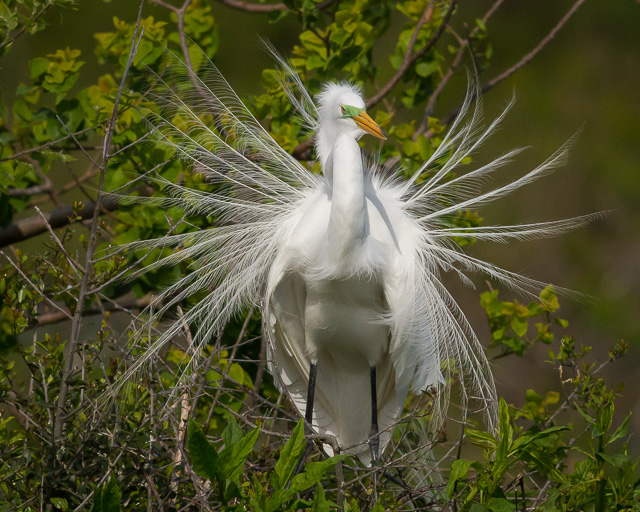 Great Egret, Rookery at Smith Oaks, High Island, Texas, Canon 7D with Canon EF 500mm, 1/8000s @ f/8, ISO 1600
Great Egret, Rookery at Smith Oaks, High Island, Texas, Canon 7D with Canon EF 500mm, 1/8000s @ f/8, ISO 1600
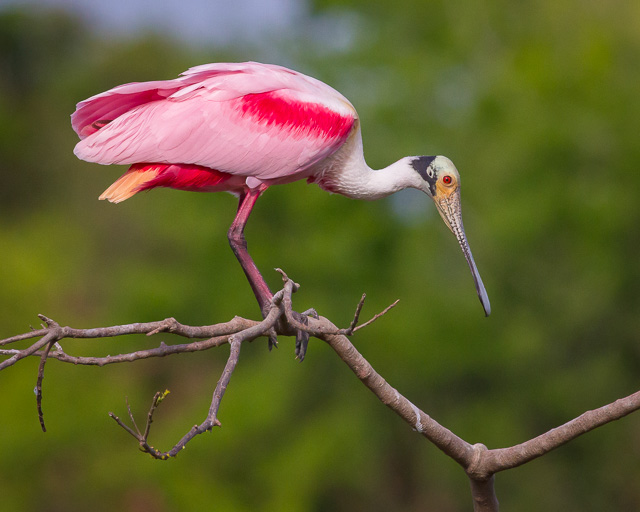 Roseate Spoonbill, Rookery at Smith Oaks, High Island, Texas, Canon 7D with Canon EF 500mm, 1/5000s @ f/8, ISO 1600
Roseate Spoonbill, Rookery at Smith Oaks, High Island, Texas, Canon 7D with Canon EF 500mm, 1/5000s @ f/8, ISO 1600
After High Island, we drove down to the Bolivar Peninsula. We saw lots of gulls, terns (including Sandwich Terns that are so named because their yellow-tipped bills make it look like they just ate a mustard sandwich), plovers, and sandpipers.
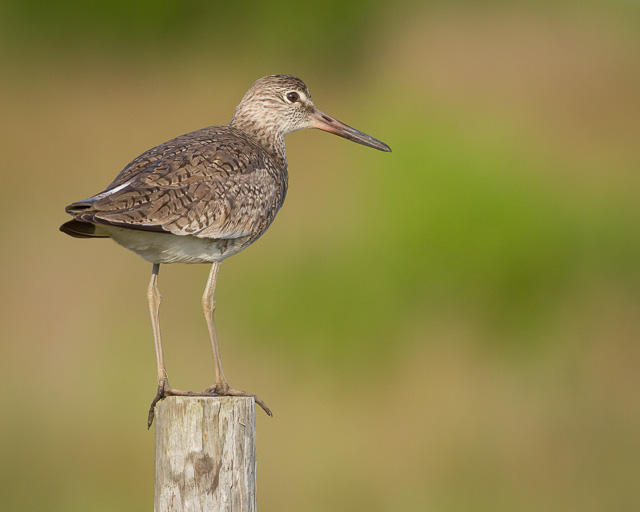 Willet, Bolivar Peninsula, Texas, Canon 7D with Canon EF 500mm, 1/3200s @ f/8, ISO 1600
Willet, Bolivar Peninsula, Texas, Canon 7D with Canon EF 500mm, 1/3200s @ f/8, ISO 1600
Finally, it was back to our hotel in Winnie. On our second day, we headed back to Boy Scout Woods and had more success. We saw Inca Doves on the telephone wires as soon as we got out of our vehicle, and some orioles and another thrasher in the woods. However, the best birds of the day were seen from the tower across the road. The tower is a rickety three-story wood structure and it didn’t give me much confidence. There were loose nails sticking out in various places and the railing wasn’t entirely intact. The walkway was not wide enough to accommodate my tripod so I had to collapse the legs together and use it as a monopod. Thankfully, the tower held together long enough to get us at eye level with some very colourful birds. There was a flock of Indigo Buntings, a Painted Bunting, Baltimore Orioles, but the highlight for me was a male Blackburnian Warbler. It stayed in view at eye level for a brief moment but my first shot had one small problem:
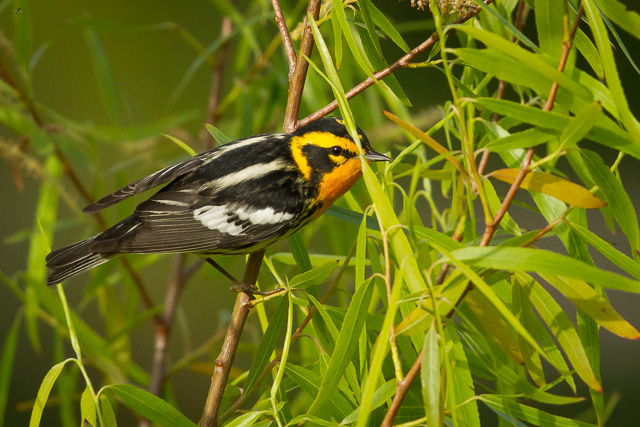 Blackburnian Warbler (obscured), Boy Scout Woods, High Island, Texas, Canon 7D with Canon EF 500mm, 1/3200s @ f/8, ISO 1600
Blackburnian Warbler (obscured), Boy Scout Woods, High Island, Texas, Canon 7D with Canon EF 500mm, 1/3200s @ f/8, ISO 1600
It’s amazing how much one thing can lessen a photo… damn you tree! Luckily, the bird moved ever so slightly that its head was no longer obscured:
 Blackburnian Warbler, Boy Scout Woods, High Island, Texas, Canon 7D with Canon EF 500mm, 1/5000s @ f/8, ISO 1600
Blackburnian Warbler, Boy Scout Woods, High Island, Texas, Canon 7D with Canon EF 500mm, 1/5000s @ f/8, ISO 1600
After Boy Scout Woods, we headed over to the smallest part of the High Island Sanctuary - Hooks Woods. It’s so small it doesn’t even get mentioned on the High Island website! Despite that, it proved fruitful for us. We saw a resting Black-chinned Hummingbird and a Blue Grosbeak on the ground amongst a flock of cowbirds.
Then it was on to Anahuac National Wildlife Refuge. We drove on the Shoveler Pond Auto-Tour loop and the highlights were an American Bittern, Black-necked Stilts, and Mottled Ducks. On the drive just outside the refuge we saw our first Crested Caracara.
We decided not to book any hotels beforehand on this trip and that decision hurt us on this day. We knew that we wanted to start our next day near Rockport. That was a long drive from Anahuac so we decided to head in the general direction of Rockport and stop when we felt like it. My old GPS indicated there was a single place to stay in Tivoli but when the helpful voice said “you have reached your destination”, we were on a country road in complete darkness in the middle of nowhere. Darn. We had no choice but to continue all the way to Rockport. We stopped at the first place we could and had a very late dinner at Whataburger. Very classy. What’s up with drink sizes in the US? I know I don’t exactly have the physique of “The Rock”, but I could hardly carry my beverage out of the restaurant!
Our first stop the next day was the Rockport Demo Bird Garden & Wetlands Pond. Highlights were a Black-crested Titmouse, Black-bellied Whistling-Ducks, and a Carolina Wren loudly singing from the treetops. Then it was on to Joan & Scott Holt Paradise Pond in Port Aransas. Paradise Pond has a short boardwalk in an area that usually has water. The drought has left it completely devoid of water but there were still thrushes, tanagers, grosbeaks, vireos, and Prothonotary Warblers and Black-and-white Warblers present. We also spotted Yellow-crowned Night-Herons relaxing in the trees on our way out. And just to prove that the trip wasn’t entirely about the birds, here’s a butterfly that was right beside the parking lot.
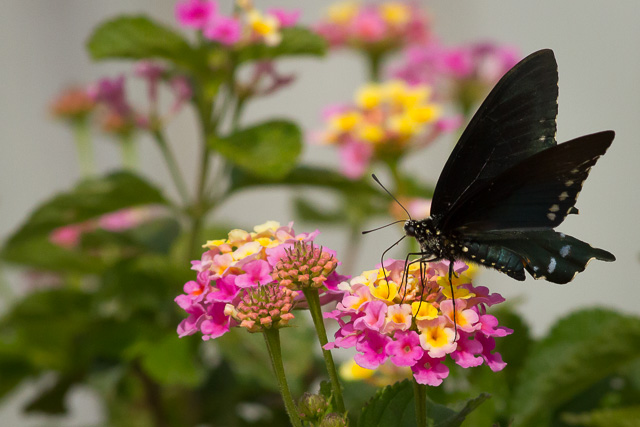 Butterfly, Joan & Scott Holt Paradise Pond, Port Aransas, Texas, Canon 7D with Canon EF 500mm, 1/8000s @ f/8, ISO 1600
Butterfly, Joan & Scott Holt Paradise Pond, Port Aransas, Texas, Canon 7D with Canon EF 500mm, 1/8000s @ f/8, ISO 1600
Our last stop in Port Aransas was the Leonabelle Turnbell Birding Center. The main attraction there is a boardwalk but even before that we saw lots of warblers, vireos, and hummingbirds in the trees and garden. As a bonus, a Sora walked around and stayed in view for much longer than usual, even allowing me to get some photos. The boardwalk allowed very close views of American Avocets, Ruddy Ducks, Northern Shovelers, and my favourite, Cinnamon Teals:
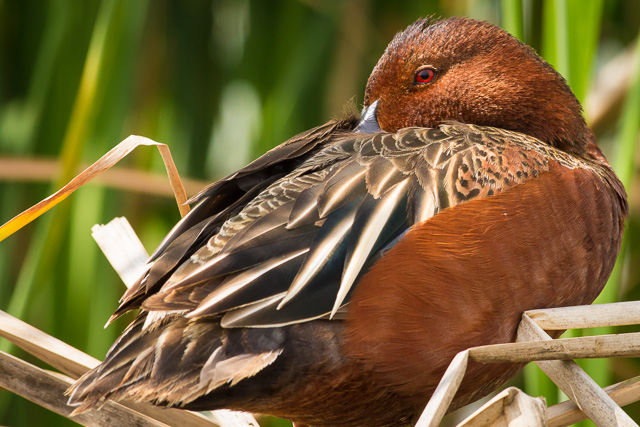 Cinnamon Teal, Leonabelle Turnbell Birding Center, Port Aransas, Texas, Canon 7D with Canon EF 500mm, 1/640s @ f/11, ISO 800
Cinnamon Teal, Leonabelle Turnbell Birding Center, Port Aransas, Texas, Canon 7D with Canon EF 500mm, 1/640s @ f/11, ISO 800
After Port Aransas, we were finally on our way to the Rio Grande Valley! We stopped at Mustang Island State Park (Eared Grebes and Least Terns up close… so cute!), the Packery Channel in Corpus Christi (Gull-billed Tern, Black-bellied Plover, Hooded Warbler, Summer Tanager) and the courthouse in Sarita. No, we didn’t get caught speeding. Rather, the courthouse is mentioned on the Great Texas Coastal Birding Trail maps as a place to look for Hooded Orioles. We initially didn’t see any (although we were entertained by some seemingly devil-eyed Bronzed Cowbirds) but on our way out there they were in the trees:
 Hooded Oriole, Sarita Courthouse, Texas, Canon 7D with Canon EF 500mm, 1/3200s @ f/8, ISO 1600
Hooded Oriole, Sarita Courthouse, Texas, Canon 7D with Canon EF 500mm, 1/3200s @ f/8, ISO 1600
We finally got to the Rio Grande Valley later that day and set up shop in the Harlingen hotel that would be our home for the next four days.
The next day we drove to South Padre Island. Side by side there is the South Padre Island Birding & Nature Center and a convention center. Which one do you think is preferred by the locals for birding? Of course, it’s the convention center! Each has a boardwalk and it’s funny to see the competing boardwalks right beside each other. You have to pay to use the birding center’s boardwalk but not the one at the convention center.
It was our first time in South Padre Island so we didn’t know the protocol yet. We started at the birding center and saw lots of rails (including Clapper Rails), dowitchers, herons, egrets, ducks, kingfishers, and my favourite, Black-necked Stilts:
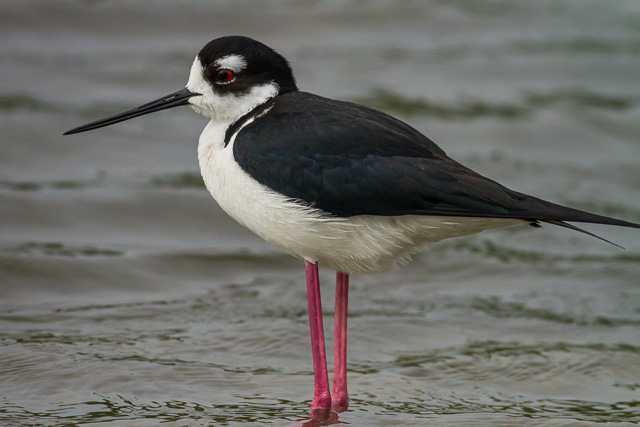 Black-necked Stilt, South Padre Island Birding & Nature Center, Texas, Canon 7D with Canon EF 500mm, 1/6400s @ f/8, ISO 1600
Black-necked Stilt, South Padre Island Birding & Nature Center, Texas, Canon 7D with Canon EF 500mm, 1/6400s @ f/8, ISO 1600
They just look so awkward on their long legs, like they would topple over if a brisk wind picked up.
We went next door to the convention center and were shocked at the size of the woods - they were barely larger than my house! However, there was a man-made fake creek running through them so the birds congregated. There were waterthrushes, orioles, tanagers, warblers (Kentucky, Black-and-white, Prothonotary, Nashville, Tennessee, Yellow-rumped, Worm-eating, and Northern Parula), kinglets, doves, and Lincoln’s and Clay-colored Sparrows. What a two hour stretch of birds! I like the face pattern on Kentucky Warblers:
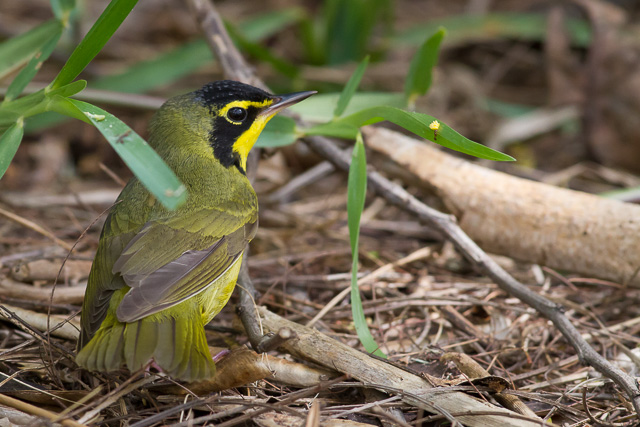 Kentucky Warbler, South Padre Island Convention Center, Texas, Canon 7D with Canon EF 500mm, 1/320s @ f/8, ISO 1600
Kentucky Warbler, South Padre Island Convention Center, Texas, Canon 7D with Canon EF 500mm, 1/320s @ f/8, ISO 1600
The next day we aimed for some true Texas specialties. We were not disappointed! We started at Estero Llano Grande and nabbed a Clay-coloured Thrush, Great Kiskadee, Least Grebe (so tiny!), and an Altamira Oriole. The latter was interesting because it fought itself in the rear view mirror of a park vehicle and it wasn’t giving an inch. It landed on the mirror, aggressively pursued its own reflection and then headed back to a tree. This process repeated a number of times. I hope it doesn’t tire itself out!
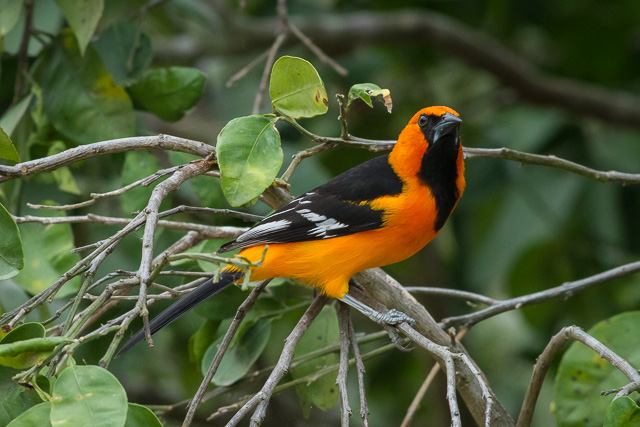 Altamira Oriole, Estero Llano Grande State Park, Texas, Canon 7D with Canon EF 500mm, 1/250s @ f/8, ISO 1600
Altamira Oriole, Estero Llano Grande State Park, Texas, Canon 7D with Canon EF 500mm, 1/250s @ f/8, ISO 1600
Another location noted for south Texas birds was next - Bentsen-Rio Grande Valley. Its roads were closed but there were so few people there that we got chauffeured around by park staff in a golf cart. They dropped us off at a photo blind and came back some time later to pick us up and take us to the next location. It was pretty sweet! A photo blind also served as the landing spot for my first camera drop. I thought my big lens was attached to my tripod, but evidently that was false. Apparently it was just lightly resting on my tripod. When I moved my tripod, down came my camera and lens, hitting the wooden floor of the photo blind with a thud. Not to worry! I picked it up and all was good. Let’s blame that one on the heat.
The next day was our final full day in the Rio Grande Valley and we started at Sabal Palm Sanctuary. They have a live webcam showing the birds at their feeders so we sort of knew what to expect. They also have had a Crimson-collared Grosbeak showing up at least daily since February. That species isn’t normally seen in the US or Canada so we were hoping to catch a glimpse. Before the grosbeak showed up, we saw more Black-crested Titmice, a Buff-bellied Hummingbird, and more Hooded and Altamira Orioles. Then it was time for the show! The grosbeak showed up at its customary spot and picked away at the apples put out by staff each morning:
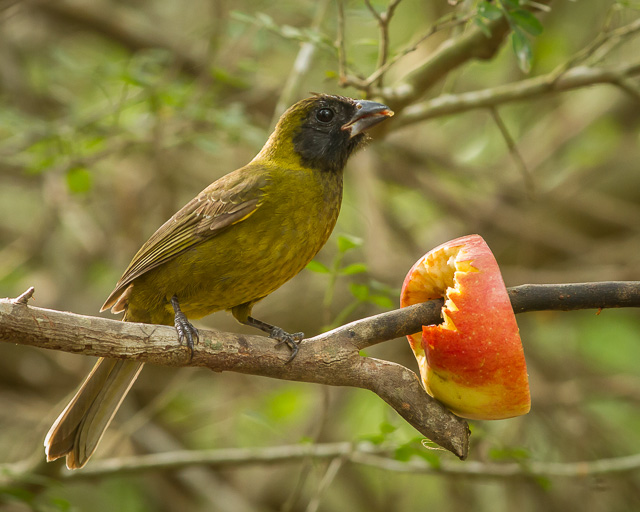 Crimson-collared Grosbeak, Sabal Palm Sanctuary, Texas, Canon 7D with Canon EF 500mm, 1/100s @ f/8, ISO 1600
Crimson-collared Grosbeak, Sabal Palm Sanctuary, Texas, Canon 7D with Canon EF 500mm, 1/100s @ f/8, ISO 1600
I tried to get a photo showing the bird without obvious human interaction but that was not to be. Note how dark it was - even at ISO 1600 I still needed a shutter speed of 1/100s.
We took Old Port Isabel Road after Sabal Palm as it is noted for sightings of Aplomado Falcon. We didn’t see a falcon, but we did see disgusting reminders of human activity. Garbage was everywhere - piles of tires, mattresses, old TVs, and car seats. If it can be discarded, it was in the ditch on Old Port Isabel Road… an interesting combination of nature and human activity:
 Ever heard of a tire fence?, Old Port Isabel Road, north of Brownsville, Texas, Canon 7D with Canon EF 500mm, 1/3200s @ f/8, ISO 1600
Ever heard of a tire fence?, Old Port Isabel Road, north of Brownsville, Texas, Canon 7D with Canon EF 500mm, 1/3200s @ f/8, ISO 1600
Old Port Isabel Road headed us in the direction of Laguna Atascosa National Wildlife Refuge so we popped in for a visit. Laguna Atascosa is probably the only place in the US where one can legitimately see the following sign:
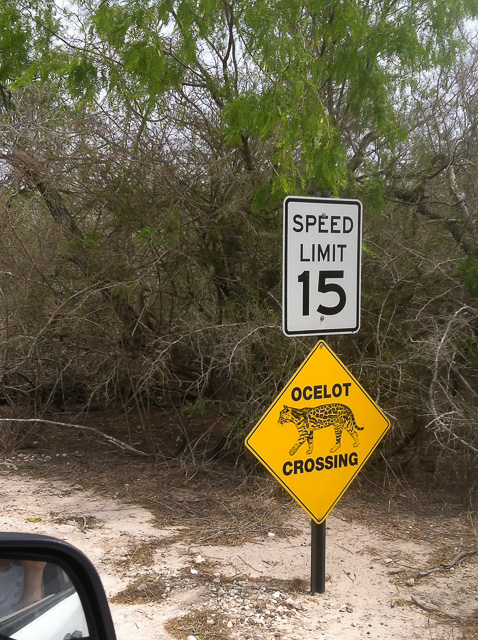 Highly unlikely but possible!, Laguna Atascosa National Wildlife Refuge, Texas, iPhone, 1/1100s @ f/2.8, ISO 80
Highly unlikely but possible!, Laguna Atascosa National Wildlife Refuge, Texas, iPhone, 1/1100s @ f/2.8, ISO 80
Wild ocelots still exist in the park, but there are few (they have tagged only three females) and they are extremely secretive (only two reported sightings in the last five years). We went on the 15-mile long auto tour and when we got out to see some shorebirds, we were surprised to see a cat off in the distance. Were we lucky enough to actually see a wild ocelot? Um, no:
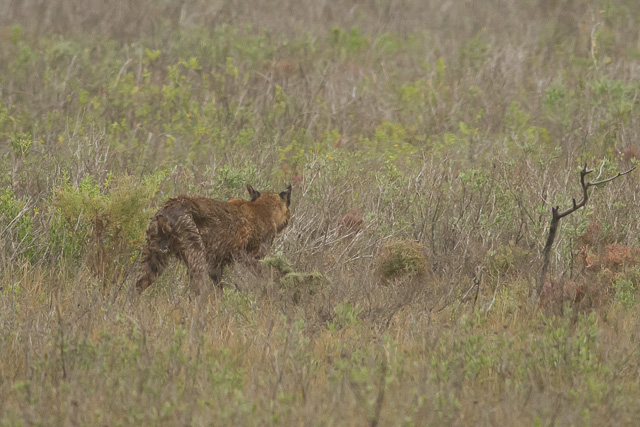 Bobcat, Laguna Atascosa National Wildlife Refuge, Texas, Canon 7D with Canon EF 500mm, 1/2000s @ f/8, ISO 1600
Bobcat, Laguna Atascosa National Wildlife Refuge, Texas, Canon 7D with Canon EF 500mm, 1/2000s @ f/8, ISO 1600
It turned out to be a bobcat. Very cool, but no ocelot.
Laguna Atascosa was also where I experimented with dropping my camera and lens on a new surface - asphalt! This time a plastic piece of my camera flew off but it was only the door for the battery compartment. I tell you, I appreciate my camera’s hardiness!
Strong northerly winds and a coming cold front had many predicting a fallout at South Padre Island for our final day. We started early and got to the convention center before sunrise. However, we weren’t allowed in the parking lot because it was reserved for attendees of the motorcycle show. Another interesting combination of nature and human activity!
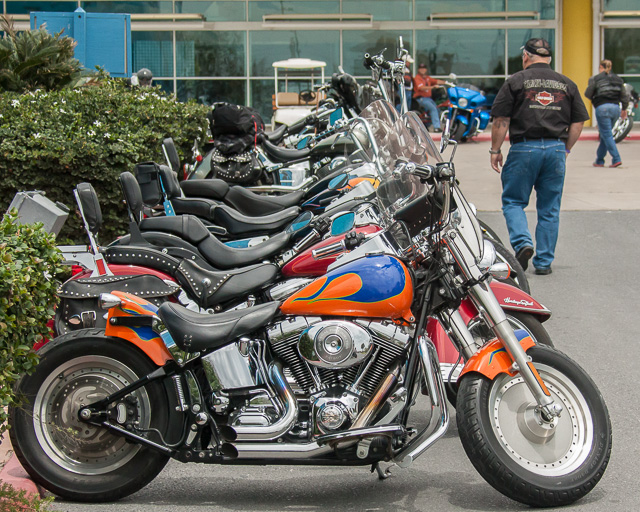 Nothing says nature like a motorcycle show!, South Padre Island Convention Center, Texas, Canon Xsi with Canon EF 28-300mm @ 60mm, 1/4000s @ f/5.6, ISO 1600
Nothing says nature like a motorcycle show!, South Padre Island Convention Center, Texas, Canon Xsi with Canon EF 28-300mm @ 60mm, 1/4000s @ f/5.6, ISO 1600
Alas, there was no fallout so birds weren’t actually falling from the sky, but there were still a ton of birds kicking around, including my best viewings of a Painted Bunting:
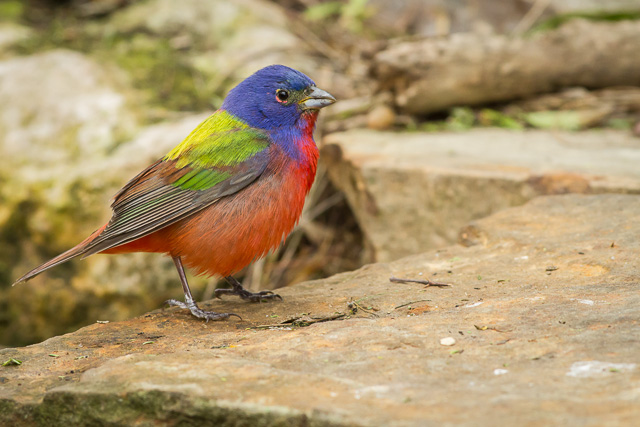 Painted Bunting, South Padre Island Convention Center, Texas, Canon 7D with Canon EF 500mm, 1/400s @ f/8, ISO 1600
Painted Bunting, South Padre Island Convention Center, Texas, Canon 7D with Canon EF 500mm, 1/400s @ f/8, ISO 1600
We had a long drive from South Padre Island to our airport hotel in Houston, so we left around 2:00 and got on the road. Our only real stop was in Refugio, at Lion’s/Shelly Park. It proved quite a good stop and, just as advertised in the Great Texas Coastal Birding Trail map, there was a Green Kingfisher:
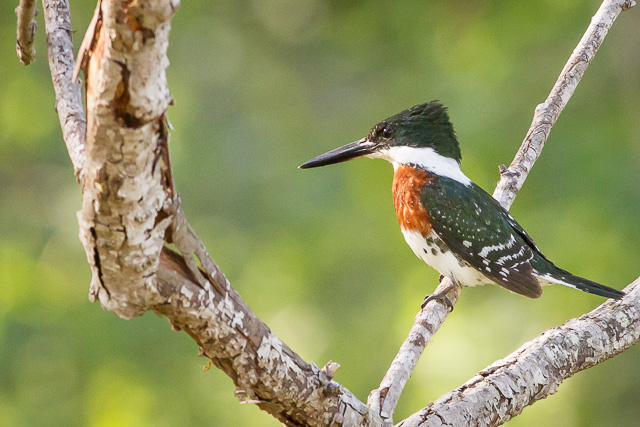 Green Kingfisher, Lions/Shelley Park, Refugio, Texas, Canon 7D with Canon EF 500mm, 1/400s @ f/8, ISO 1600
Green Kingfisher, Lions/Shelley Park, Refugio, Texas, Canon 7D with Canon EF 500mm, 1/400s @ f/8, ISO 1600
Even better, it was in good light and didn’t move! I tried to get a shot of it in flight as it took off, but it was too fast. We also added three more species to our Texas list - Solitary Sandpiper, Blue-Gray Gnatcatcher, and finally, a Carolina Chickadee! We made it to Houston only to see a giant cockroach on the floor of our hotel room. Cue the room change (as far away from the infestation as possible, please). Our whirlwind tour of coastal Texas was over and it was a blast!
Our trip home was more eventful than expected. Weather was perfect in Houston but our flight to Detroit was delayed so we would have missed our connection. The earliest they could get us to Syracuse was 10:30 PM via Minneapolis so our final day involved five hours of waiting at the Houston airport, a short flight to Minneapolis, a four-hour wait there for our short flight to Syracuse, and then a three-hour drive home in the dark. Oh well, it all worked out for the best and the delays actually helped me get some of my photo editing done earlier than it otherwise would have.
Reader Comments (1)
RootMonument Valley is the game for android users. You can enjoy this game by downloading Monument Valley APK from following the steps suggested in this post. monument valley apk free download